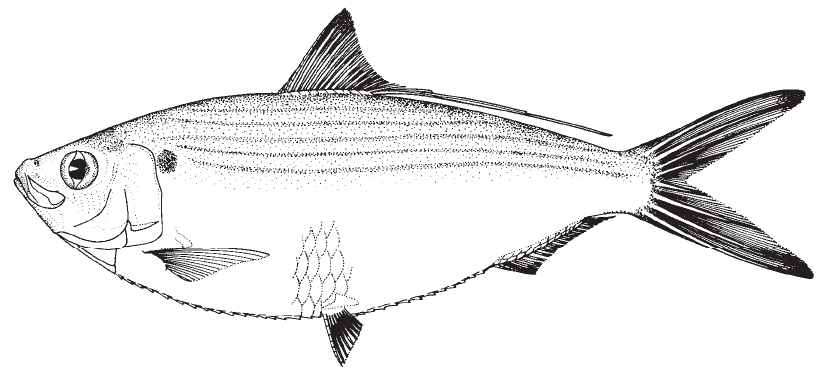Diagnostic characters
Body fusiform, moderately compressed; abdomen with 32 to 36 scutes forming a distinct keel. No hypomaxilla; gill rakers fine and numerous, increasing with size of fish up to 12 cm standard length, then stable at 28 to 46 gill rakers. Posterior margin of gill chamber with 2 fleshy lobes. Dorsal fin slightly anterior to centre point of body, its last ray filamentous; anal fin short and placed well posterior to vertical through posterior base of dorsal fin; 7 branched pelvic-fin rays, pelvic-fin origin inserted at point about at vertical through middle of dorsal-fin base. Colour: dorsum and upper sides blue-green, sometimes with dark horizontal lines, lower sides and abdomen silvery; dark spot on side posterior to gill cover, about equal in size to diameter of pupil (followed in some specimens by one or more irregular lines of smaller spots); margin of dorsal fin and its filament dusky; caudal fin with black tips.
|
Habitat, biology, and fisheries
Pelagic, coastal, migratory, often forming compact surface schools (but solitary individuals reported); schools from southeastern United States migrate south during autumn and winter when temperatures fall below 20C, presumably to overwinter. Prefers temperatures above 17C and below 29C; salinity 32 to 34‰, probably does not enter low salinity waters.Spawning period May and June off North Carolina, February to September (peak April to August) in eastern Gulf of Mexico, possibly March to July off Venezuela. Recruitment occurs throughout the year, with maximum in summer. Females mature at 135 to 169mmfork length. Estimated fecundity 13,638 to 67,888 eggs; relative fecundity 471 to 746 eggs/g.Eggs pelagic, 1.08 to 1.31 mm. Adults feed on small fishes, crabs, and shrimps; juveniles on planktonic organisms. Predominately taken in artisanal and industrial fisheries. Caught throughout the area, targeted off Costa Rica, and Venezuela, the continental margins of the Caribbean, the Gulf of Mexico, and near the islands of Cuba, Hispaniola, Puerto Rico, Jamaica, and Trinidad, also off coasts of Ecuador and Peru. This species represents a relatively important fishery resource in some regions. The total reported catch in 1995 was 7,737 t (Venezuela: 307 t; USA: 5,056 t; Cuba: 2,005 t; Dominican Republic: 369 t). Caught with beach seines, purse seines, and cast nets, sometimes gill nets and as bycatch in the trawl fishery for shrimps. Marketed fresh, frozen, salted, and as bait; also of growing importance in fish meal and fish oil industry; minor quantities for human consumption, occasionally canned as ‘sardine’; processed into pet food.
|
Distribution
Western Atlantic (Gulf of Maine, Bermuda, throughout Gulf of Mexico, Caribbean and West Indies, southward to Santa Caterina, Brazil). Also off coasts of Ecuador and Peru.
|
